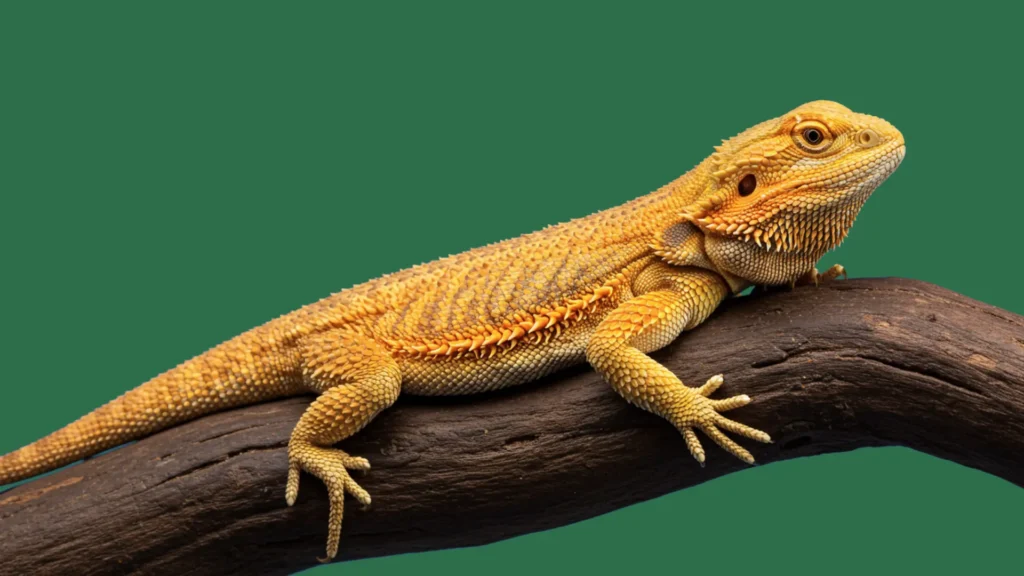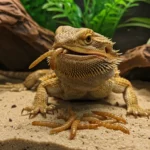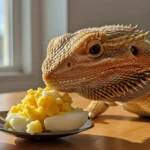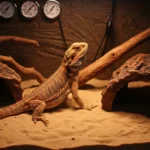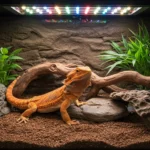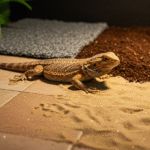The orange bearded dragon is more than just a colorful reptile—it’s a favorite among lizard lovers for its fiery appearance, friendly demeanor, and photogenic charm. Known for their vibrant shades that range from soft peach to deep tangerine, these dragons are a standout in the world of exotic pets. Whether you’re a first-time reptile owner or a seasoned enthusiast looking to expand your collection, the orange bearded dragon offers a perfect blend of beauty and personality.
But what makes this morph so special? From their genetics and care needs to their rising popularity across social media, there’s a lot to love—and consider—before bringing one home. In this guide, we’ll explore everything you need to know about the orange bearded dragon, including its unique traits, cost, habitat setup, and expert care tips to keep your dragon healthy and happy.
What Makes the Orange Bearded Dragon So Popular?
The orange bearded dragon is more than just a pretty face. With its fiery appearance, gentle behavior, and social media fame, this unique morph has earned a special place among reptile lovers. Let’s explore the top reasons why the orange morph stands out.
Orange Bearded Dragon Colors: What Makes Them So Vivid?
Orange morphs display an eye-catching palette that ranges from soft peach to bold tangerine. These orange bearded dragons often appear brighter than red or yellow types, offering a striking balance of warmth and intensity. Their vibrant scales are especially dazzling under natural sunlight or high-quality UVB lighting—both essential for showcasing their full color potential.
In comparison to citrus or red morphs, orange variants offer a unique glow that feels both warm and bold. This visual brilliance is one of the main reasons they’re a top choice among keepers and collectors alike.

Orange Bearded Dragon Temperament: Are They Friendly?
Personality is just as important as appearance—and orange bearded dragons don’t disappoint. Known for their laid-back nature, they tend to be more relaxed and easier to handle than some other morphs. This makes them ideal for beginners, families, and even children under supervision.
Many owners report that orange morphs enjoy gentle interaction and regular handling. Their easygoing temperament makes care routines smoother and strengthens the bond between dragon and keeper.
Why Social Media Loves the Orange Morph
From TikTok to Instagram, the orange bearded dragon is a true influencer in the reptile world. Their bold colors and charming expressions make them stand out in any video or photo. As a result, breeders have leaned into this demand—producing brighter, rarer morphs that often go viral.
This surge in visibility has made orange dragons a favorite not just for pet lovers, but also for collectors who want something truly eye-catching. Some breeders now specialize in high-end orange morphs with enhanced traits like translucency or hypo genetics.
Understanding Orange Bearded Dragon Morphs and Color Genetics
Orange bearded dragons are the result of years of selective breeding. Their vivid color and unique traits make them one of the most visually appealing reptiles in the hobby. To choose the right orange morph—and care for it properly—you need to understand how these colors are created and what each variation means.
What Is a Morph and How Is It Created?
In reptiles, a morph refers to a genetically distinct variation in color, pattern, or physical traits. These changes aren’t random—they’re the result of selective breeding by reptile enthusiasts and professional breeders. By pairing dragons with desirable traits over multiple generations, breeders can create offspring with specific colors, like orange, red, or citrus. This practice allows breeders to isolate certain genetic traits that wouldn’t typically occur in wild bearded dragons.
Not all morphs are created equal. Some are more common and easier to breed, while others are rare and require more precise pairings. Morphs with intense coloring, such as the orange bearded dragon, often command higher prices because of their visual appeal and market demand. Traits like smooth scales, clear nails, and bright eyes can also affect a dragon’s value. Understanding what a morph is—and how it’s made—gives new owners better insight into what they’re buying and why prices vary so widely.
Popular Orange-Based Morphs Explained
Not all orange bearded dragons look the same. Their appearance depends on the specific morph they belong to. Some of the most common orange-based morphs include the citrus morph, the tangerine bearded dragon, and the hypo bearded dragon. Each offers a unique blend of color, scale texture, and pattern. For example, citrus morphs tend to have bright yellow-orange tones with sharp contrast, while tangerine morphs show a deeper, richer orange that may darken with age.
Hypo (short for hypomelanistic) dragons have reduced melanin, giving them a lighter and often smoother appearance. Their nails are typically clear, and their colors appear cleaner overall. Some orange morphs have a translucent trait, meaning they have slightly see-through skin around their belly and eyes when young. These visual differences not only affect how they look but also influence their price and rarity. Knowing the features of each morph helps you find one that fits your taste and experience level.
Are Orange Variants Rare or Readily Available?
The availability of orange morphs varies depending on the specific type and the breeder’s focus. Basic orange dragons—those with mild coloration and no rare genetic traits—are often available at large pet stores or common breeders. These dragons are usually more affordable and easier to find. However, high-end orange bearded dragons, especially those with citrus, hypo, or translucent traits, are less common.
Limited-edition morphs are often bred by specialized breeders who prioritize color vibrancy and genetic health. These dragons are usually sold through reptile expos, breeder websites, or waitlists. Because demand for vivid orange coloration has risen, particularly through social media exposure, some breeders now focus heavily on producing the most intense versions. While you can find orange dragons fairly easily, the rarest and most vibrant morphs are considered premium and may come with a higher price tag.
Caring for an Orange Bearded Dragon: Expert Tips
Bearded dragons come in a wide range of colors and patterns, thanks to selective breeding and genetic variation. Understanding how these morphs are created—especially vibrant ones like the orange bearded dragon—can help you choose the right pet for your lifestyle and preferences.
👉 For a deeper dive into how these stunning morphs are developed, check out our guide on Bearded Dragon Selective Breeding: Everything You Need to Know.
Setting Up the Ideal Habitat and Lighting
Creating the right environment is essential for your orange bearded dragon to stay healthy and show off its vivid color. Start with a spacious enclosure—at least 40 gallons for adults—so they have room to move, bask, and explore. Within the tank, you’ll need a proper temperature gradient, including a basking spot around 95–105°F and a cooler area near 75°F. This allows your dragon to regulate its body heat naturally.
Lighting is just as important. A high-quality UVB lamp is crucial for bone health and calcium absorption. Without UVB, your dragon could develop serious health issues, like metabolic bone disease. Good lighting also enhances their natural coloration, making orange tones appear brighter and more defined. Replace UVB bulbs every six months, even if they still emit light, as the UVB output fades over time. With the right setup, your dragon will thrive both physically and visually.
What to Feed Your Dragon for Bright Colors and Health
A balanced diet is key to keeping your orange bearded dragon healthy and vibrant. Their meals should include a mix of insects and leafy greens, adjusted by age. Juveniles need more protein, so offer gut-loaded insects like crickets, dubia roaches, and black soldier fly larvae several times per day. Adults, however, require more vegetables and less protein, with insects given a few times per week.
Calcium and vitamin supplements are important. Dust food with calcium powder three to five times a week and add a multivitamin once or twice weekly. Offer fresh greens daily, such as collard greens, mustard greens, and dandelion leaves. Bright orange fruits or vegetables like butternut squash and carrots can be offered in small amounts. While they don’t directly cause brighter colors, a nutrient-rich diet supports healthy skin and overall vitality. Proper nutrition ensures your dragon looks and feels its best.
Signs of Illness or Poor Husbandry to Watch Out For
Monitoring your bearded dragon’s health is just as important as providing food and lighting. Some signs of illness are easy to miss but can quickly become serious if ignored. Watch for symptoms like lethargy, sunken eyes, lack of appetite, or unusual stools. These may indicate dehydration, parasites, or a poor diet. Stress symptoms, such as glass surfing or constant hiding, can also signal that something is wrong with their environment.
Improper husbandry—like dirty enclosures, incorrect temperatures, or lack of UVB lighting—can weaken their immune system. Make sure to clean the tank regularly and check temperatures daily. Schedule routine checkups with a reptile vet at least once a year, or sooner if symptoms appear. Early detection is the best way to prevent health issues from becoming life-threatening. By staying observant and maintaining proper care, you can ensure your orange dragon stays active and healthy.
Orange Bearded Dragon Cost: Is It Worth the Price?
While orange bearded dragons are known for their beauty and charm, they often come with a higher price tag than standard morphs. Before making a purchase, it’s important to understand what influences their cost and what long-term expenses to expect. Let’s break down the price factors and see if owning one is truly worth the investment.
Pricing Guide by Morph Type and Source
The cost of an orange morph varies depending on its genetic traits and where you buy it. Basic orange bearded dragons from large pet stores typically range from $75 to $150. These dragons often have less vivid coloring and unknown genetic backgrounds. In contrast, buying from a specialized breeder can cost anywhere from $200 to over $500, especially for hypo, citrus, or tangerine morphs with strong coloration or rare traits.
Factors like genetics, morph purity, age, and lineage greatly influence the price. Juveniles may be more affordable, while adults with proven genetics or unique features often cost more. Breeders may also include health guarantees or care support, which adds value. While the initial price can be high, many owners see it as a worthwhile investment for a healthy, visually stunning pet.
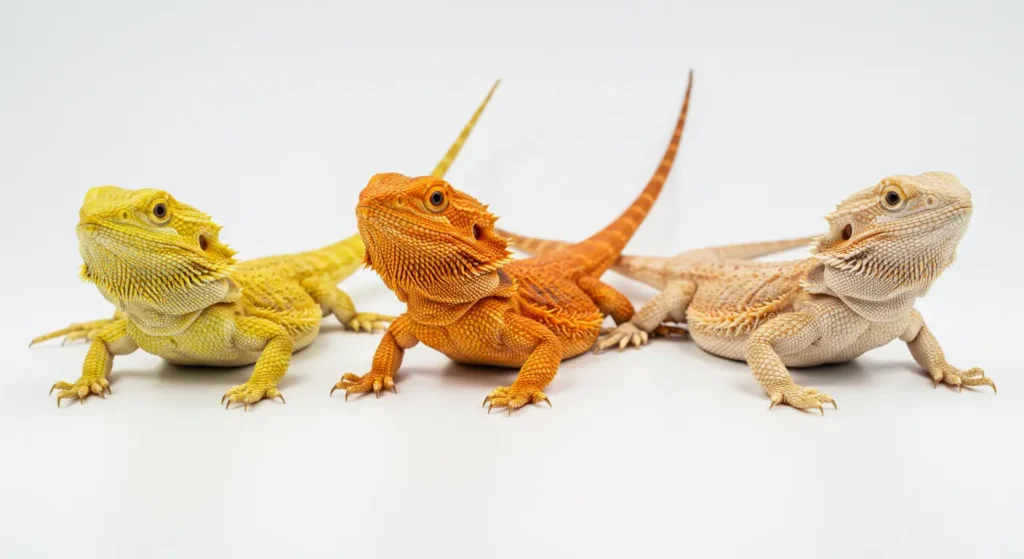
What Are the Monthly and Annual Ownership Costs?
Beyond the purchase price, you’ll need to consider the ongoing care cost of owning an orange bearded dragon. Monthly expenses typically include food, calcium supplements, and electricity for heating and lighting. Feeding a juvenile can cost $30–50 per month, while adult dragons may cost slightly less due to fewer insects. UVB and basking bulbs need replacement every six months, which adds to the annual cost.
Vet checkups, though not always needed monthly, are important for long-term health. A basic wellness visit may cost $60–100, and emergency care can be much higher. Unexpected costs—such as replacing a broken light fixture or treating parasites—should also be part of your budget. On average, yearly ownership costs range from $500 to $1,000. Planning ahead helps ensure your dragon receives proper care without financial strain.
Setup Costs: What You Need Before Bringing One Home
Before bringing your orange bearded dragon home, you’ll need to invest in a proper habitat. This includes a reptile tank (usually 40 gallons or larger), which can cost between $100 and $200. You’ll also need essential items like a basking bulb, UVB lamp, thermometers, a hide, feeding bowls, and substrate. Altogether, your startup expenses may total $300 to $500.
Some costs can be reduced with smart planning. For example, you can buy enclosure kits that include lighting and accessories. DIY decor and reusable feeding tools also help save money. However, it’s important not to cut corners on lighting or heating, as these are vital to your dragon’s health. A well-planned setup ensures your pet adjusts comfortably and starts off in a safe, stress-free environment.
Choosing the Right Orange Morph for Your Lifestyle
With several orange morphs to choose from, finding the right orange bearded dragon depends on your lifestyle, experience level, and personal preferences. Some morphs are easier to care for, while others may require more attention or come at a higher cost. Let’s look at how to choose the perfect match for your needs.
Which Morph Fits Beginners, Breeders, or Collectors?
Not all orange bearded dragons are created equal—some are ideal for first-time owners, while others appeal more to experienced breeders or collectors. If you’re looking for an easy-to-care-for reptile, consider basic orange morphs or citrus types. These tend to have simple care requirements and are widely available. They’re also more affordable, making them a great choice for beginners.
Breeders and collectors often seek rare or high-end morphs like hypo or translucent orange dragons. These may display more vibrant colors or unique traits but can require more attention to detail in their care. Some high-end dragons also have sensitive genetics or specific needs related to UVB exposure or feeding. Understanding your lifestyle and experience level will help you choose a morph that you can manage confidently and enjoy for years to come.
Selective breeding plays a huge role in how vibrant an orange bearded dragon can appear. If you’re curious about the most visually striking morphs, be sure to check out our guide to the Top 5 Morphs from Bearded Dragon Selective Breeding.
How to Identify a Healthy Orange Bearded Dragon Before Buying
Choosing a healthy dragon starts with knowing what to look for. A good visual inspection can prevent future problems. A healthy orange bearded dragon will have bright, alert eyes, active behavior, and a firm, well-rounded body. Its limbs should be strong and straight, with no signs of dragging or deformity. The tail should taper evenly, and the skin should be free from injuries or stuck shed.
Avoid dragons that appear sluggish, overly thin, or have cloudy eyes. Also be cautious if the dragon is kept in poor conditions or with multiple animals in a small enclosure. Buying from reputable breeders is always the safer choice. They can provide background on the dragon’s genetics, diet, and health history. A strong, healthy start gives your dragon the best chance to thrive long term.
Questions to Ask Breeders or Sellers
Before making a purchase, come prepared with a buyer checklist. Ask the breeder or seller about the dragon’s genetics—knowing whether it’s a hypo, citrus, or tangerine morph will help you understand its needs and value. Request details about the current diet, how often it eats, and whether it has been offered both insects and greens. This gives insight into how well it’s been cared for.
You should also ask about its lighting setup. Proper UVB exposure is essential for long-term health. Don’t forget to ask about return policies or health guarantees, especially when buying from online sources or reptile expos. A reputable seller should be transparent and willing to answer all your questions. This extra step can save you stress, money, and heartache later on.
Frequently Asked Questions
Are orange bearded dragons a specific breed or just a color morph?
Orange bearded dragons aren’t a separate breed. Instead, they represent a color morph of the central bearded dragon (Pogona vitticeps). Breeders achieve their bright coloration through selective breeding for orange, citrus, or tangerine tones.
How much does an orange bearded dragon cost on average?
The cost of an orange bearded dragon typically ranges from $100 to $500. Factors like morph type, color intensity, and the breeder’s reputation affect the price. Rare morphs such as hypo citrus or translucent orange dragons usually cost more.
Do orange bearded dragons need special care compared to regular ones?
Orange morphs follow the same care routine as standard bearded dragons. To help them maintain vibrant coloring, owners should provide proper lighting, hydration, and a nutrient-rich diet with calcium and vitamin supplements.
What is the lifespan of an orange bearded dragon?
When you provide proper care, an orange bearded dragon can live 10 to 15 years in captivity. Their lifespan depends on diet, enclosure conditions, genetics, and regular vet care.
Can I find orange bearded dragons in pet stores, or only through breeders?
You can find basic orange morphs at reptile-focused pet stores. However, if you’re looking for high-end or rare variations, you’ll have better luck with reputable breeders or reptile expos. Breeders also tend to share more information about health and lineage.
What size tank does an orange bearded dragon need?
Adult orange bearded dragons thrive in tanks that hold at least 40 gallons. For more comfort and space, use an enclosure that holds 50–75 gallons, which allows for proper basking and temperature zones.
What are the signs of a healthy orange bearded dragon?
Look for clear, alert eyes, strong limbs, and active behavior. A healthy orange bearded dragon eats regularly and reacts to its environment. Avoid dragons that appear sluggish, overly thin, or have sunken eyes.
Conclusion
The orange bearded dragon is more than just a beautiful reptile—it’s a rewarding pet that combines striking color, a calm temperament, and a manageable care routine. Whether you’re a first-time owner or an experienced reptile enthusiast, understanding the differences in morphs, care needs, and costs will help you make the best decision for your lifestyle.
By providing the right environment, a balanced diet, and regular health checks, you can ensure your orange morph lives a long, healthy life while showcasing its vibrant color. If you’re ready to add a bold and fascinating companion to your home, the orange bearded dragon might be the perfect fit.
Still have questions or experiences to share? Drop them in the comments—we’d love to hear from fellow reptile lovers!

